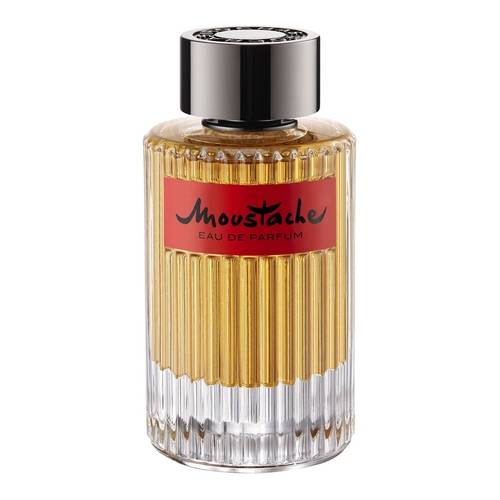Rochas reinterprets its Mustache fragrance as an Eau de Parfum
Mustache was born in 1949 and is celebrating its 70th anniversary as such. Addressing a new generation of men, today it is being transformed into an Eau de Parfum. More explosive, virile and alive than before, it takes us to a timeless territory, loaded with sensuality.
Mustache de Rochas, a small olfactory revolution
Rochas has not chosen to give pride of place to just any perfume in its history. In fact, Mustache made a loud noise when it was created. Until him, masculine essences tended to be sorely lacking in personality. Men’s perfumery was not yet fully developed. These gentlemen then perfumed themselves with simple Eaux de Cologne. Mustache has dared to offer us a new representation of perfumery, defining an unprecedented refinement for men. Its name, meanwhile, appeared obvious to the eyes of its creator when he visited the Louvre and stopped in front of the portrait of Charles I of England, painted by the painter Van Dyck. It is precisely the whole personality of this strong and conquering man that resurfaces from this essence.
Mustache Eau de Parfum, an explosive recipe in a timeless bottle
Mustache Eau de Parfum offers itself a whole new recipe, both harmonious but very contrasting. This perfume plays on unexpected assemblages between ingredients that are opposed to everything. At first, the tangy freshness of the mandarin is counterbalanced by the spicy heat of the pink berries. This cheeky boot is both lively and attractive. Then, Mustache Eau de Parfum is enriched with an elegant and woody heart, blending Bulgarian rose with Atlas cedar. The masculine and feminine codes intermingle as if to better confuse the issues. Powerful and dense at the same time, Mustache Eau de Parfum further amplifies its very pronounced character with a darker flavor of patchouli. His virility gradually becomes warmer. Finally, Mustache Eau de Parfum is ends with a combination of vanilla and benzoin. Everything is presented to us in a timeless bottle, similar to that of the very first Rochas composition. Its bottle forms a thick and finely carved glass cylinder. Its solid base is a pledge of all its virility, just like its metallic black cap. Its iconic red label still decorates its front face. Only its juice is more amber than before, as if to materialize all the warmth and sensuality it contains in its heart. Its iconic red label still decorates its front face. Only its juice is more amber than before, as if to materialize all the warmth and sensuality it contains in its heart. Its iconic red label still decorates its front face. Only its juice is more amber than before, as if to materialize all the warmth and sensuality it contains in its heart.
To celebrate the 70th anniversary of its Mustache fragrance, the Rochas brand decided to reinterpret it in an Eau de Parfum released in 2016. In 1949, Edmond Roudnitska produced the Mustache fragrance, and Nathalie Gracia-Cetto imagine its reinterpretation. The Mustache Eau de Parfum is more daring than its predecessor. It is aimed at seductive men, men who dare and have no fear. Explosive and contrasting, the composition of the new Mustache has nothing to envy to the original.
Nathalie Gracia-Cetto reinterprets Mustache Rochas
Born in the heart of the perfume capital, in Grasse, Nathalie Gracia-Cetto nevertheless left her paradise at the age of 7 to settle in Cairo (Egypt). Nathalie Gracia-Cetto then wanted to make creams and initially oriented herself towards studying pharmacy. She then joined the Givaudan perfume school, before being hired there. From her exile, Nathalie Greco-Cetto has kept the love of flowers, mimosa and especially jasmine. Really full of talent, Nathalie has an eye for detail and loves perfection. Its perfumes wonderfully symbolize “An alchemy between lightness and depth”. We owe him beautiful fragrances such as “Quatre” by Boucheron, “Le Mâle Essence de Parfum” by Jean-Paul Gaultier or even “Love Chloé” by Chloé .
The powerful and contrasting notes of Mustache Rochas
The composition of the Mustache Eau de Parfum takes off on the tangy freshness of mandarin, immediately enhanced by the berries of roses. Native to southern Asia, mandarin is particularly cultivated in Japan and China. The mandarin owes its name to the color of the mandarins’ silk dresses. It was Corsica which was the first to cultivate clementine, from 1925. In perfumery, the essence of mandarin is obtained by cold expression of the peel. Mandarin gives off sweet, fresh, tangy and candied tones. The heart of Mustache is then contrasted and sows confusion, because it combines Bulgarian rose and Atlas cedar. Originally from the mountains of North Africa, the Atlas cedar was introduced to Europe in 1734. It resists the cold perfectly and has been used to repopulate many forests. Its persistent and stiff needles are isolated on long twigs, and clustered in tufts on short twigs. In perfumery, sawdust from a tree is steam distilled. Atlas cedar offers soft, woody, camphoric and leathery tones. It is very popular with noses. Finally, the base combines patchouli, vanilla and benzoin. Patchouli made its debut in perfumery in the mid-19th century. At that time the cashmere shawls that came from India were wrapped in patchouli leaves to fight against moths. However, we had to wait for the hippie years, of which patchouli became the emblem. It is then associated with the new definition of love, sensuality, sexual freedom. Today,
Oriental
